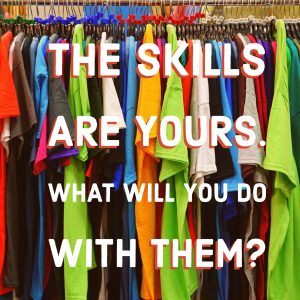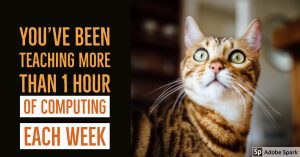Printing For a Purpose: Custom Made T-Shirts
In an ICT club many years ago, one of our projects was to custom design and print our own t-shirts, including printed arm bands. This was a popular project; students were always very enthusiastic and eager to bring their creativity to fruition, in the process learning advanced graphic design skills, how to interoperate between programmes and devices and producing real-world outcomes. Adding superheroes, animals and selfies to the mix, creativity abounded. It was printing for a purpose.
The theme was “Crazy Characters & Crazy Comics”, creating new superhero crazy characters by superimposing the heads/wings/tails of various animals onto images of superheroes and painting on designs, logos and editing the costume: a horse driving a car, an emperor hulk penguin, a super pigeon, green rabbit or super you, etc. Merge these characters into a one document, add a few speech bubbles and posh up the background. Voila! You’ve got a crazy comic. There was certainly much fun and laughter!
The Real World Computing Journey
1. Creating An Image Library: Students searched the web for copyright-free images of superheroes, animals, cars, etc and learn to create and organise a personal image library on their home drives with folders and sub-folders. Like any well-run filing system, files and documents increase in number over the years and finding a particular item amongst a large unorganised collection would be like looking for a needle in a haystack unless it was properly categorised; instill good habits early. Of course there is the online safety, copyright and digital citizenship aspects as well. Why is an organised file structure important when designing your own website, app or game in today’s real-world? Why is it important to consider copyright?
2. Digital Selfies: Students used digital cameras to take a variety headshot selfies in different poses: happy, excited, mad, angry, surprised, weird, funny, looking up/down/left/right, etc. Doing these all at once taught pupils to save time and effort later on should they want to change photos. They also had to investigate how much to zoom in/out and check the result once they imported the photos into the graphics package and compared the pixel size of their headshot to that of their superhero. They would have to learn how to resize images to match the pixel size of the destination file. How does image size and type affect the quality of presentation and speed of the app/website/game—or loading that webpage?
3. Graphic Design Skills: The IT skills originated from the old QCA unit 4B Developing Images Using Repeating Patterns, but for this project the skills were adapted, modified and most definitely advanced. Students were taught to manipulate images, investigating and using every special effect tool and varying brush styles, types and colour shades to create their crazy character. How can graphic design skills be used to up-level projects in Scratch or create that high quality engaging advert/display for your STEAM product, to engage that authentic audience? How does using online image and text generators impact on our abilities to produce original designs?
4. Printing: Students had to learn to print onto iron-on transfer paper—and we messed a few up, which taught us to practise on scrap paper first, marking it “this side up” and inserting it into the printer/MFD. We can learn from mistakes. Once printed, the design was ready to be ironed onto the t-shirt. (Students either brought in their own t-shirt or we ordered plain white ones from Amazon.) Oops! We messed up a shirt, too. The image came out backwards. This meant that together, we would have to stretch our learning and understanding of how our finished product is made, advancing our learning even more in order to reverse-flip the final crazy comic, save it accordingly and then print it out correctly. Now, we could iron it on the shirt. Voila! We had a cool, custom made t-shirt. How is responsive design coded on an app or website to allow images and text to be resized or manipulated automatically on any device?
The T-shirts looked awesome; students were proudly showing them off during assembly wearing them in class and with beaming smiles, celebrating success with their parents. Although these students will most likely remember the t-shirt they made, the valued-added of what they learnt in that ICT Club is hard to measure.
Reflection
Upon observing students over time, those who attended ICT club had increased confidence in embracing new technologies, gained a broader understanding of how technologies interoperate, built a greater resilience and perseverance when tackling challenging assignments and technical issues, strengthened their growth mindset, learning from mistakes and developed an enhanced curiosity of learning. Computing: the use of digital technology to solve problems, “How can we can custom design and print our own t-shirts?”
Even Better If…
As John Maxwell said, “Experience is not the best teacher. Evaluated experience is.” There was nothing wrong with printing custom-made t-shirt for ourselves. However, applying a STEAM approach and using the Engineering Design Process could really augment this project in numerous ways. Students be enterprising, learning budgeting skills in maths, do their own costings and use spreadsheets to learn about profit and loss in order to sell their t-shirts to the community. They can learn character development through linking this project to support a charity or create crazy comics to help spread joy and happiness. They could develop an app or website to help market this, using persuasive writing techniques learnt in class and have local business people come in and be a critical friend to critique and help up-level their work. And much more.
The Future
Not every student will grow up to be a computer scientist, but almost every job will need the skills that Computing teaches. A bakery might need someone to design the menu or advert for their food delivery app. A garage might need mechanics to understand their newly automated inventory system. An aspiring artist, singer or footballer might want to retain creative control over their promotional materials, digital designs and concepts and self-promote. Who knows, perhaps one of these students may grow up to design t-shirts for well-known companies or start their own business.
#RealWorldComputing is more than just IT skills. It’s the thinking and learning processes. It’s growth and innovative mindsets. It’s learning to overcome technical issues. It’s understanding how technologies interoperate. It’s investigating. It’s exploring. It’s trial and error. It’s having fun.
It’s Real-World Computing.


